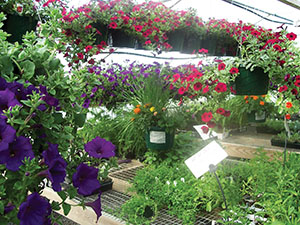Growers: Make Friends with the Good Bugs to Battle Pests
 |
|
Guardian plants support greenhouse IPM by performing indicator, trap, banker, and habitat functions. Source: Carol Glenister, IPM Laboratories, Inc. |
“Aphids are the number one pest of vegetables in Northeast high tunnels,” says Margaret Skinner, an entomologist at the University of Vermont. “They stunt plant growth, secrete sticky honey dew, and transmit viral diseases. The bottom line is they cost growers money.”
While some growers reach for an insecticide, Skinner and her team are studying plants as a foundation in an IPM approach to manage aphids and other pests cost-effectively.
For example, indicator plants are used to scout for the pest; trap plants lure pests from the crop so growers can use a targeted spot treatment; banker plants provide host insects to support natural enemy populations; and habitat plants are groups of flowering plants that combine all the functions into one, luring pests away from the crop, drawing natural enemies from the surroundings, and providing food—nectar and pollen—to support beneficial organisms and pollinators.
In high tunnels, Skinner and her colleagues grow clumps of alyssum, bush green bean, marigold, and lantana, to see how these plants could support commercially available natural enemies, such as Orius insidiosus, Aphidus colemani, and Aphidoletes aphidymiza, and attract naturally-occurring beneficial organisms.
Pest Explosion
Western flower thrips spell bad news for flower growers. Skinner’s research has shown that flowering marigolds can lure thrips from bedding plant crops like petunia, calibrachoa, osteospermum, verbena, and impatiens, especially when the marigolds are put in the crop early, before it begins to flower.
For many years, Skinner and her team have worked one-on-one with growers to teach them the IPM approach and several of its techniques, such as use of sticky cards and indicator plants for early pest detection; identification and removal of virus-infected plants; and spot treatments rather than greenhouse-wide sprays to reduce pesticide use. They also show growers how to refine biocontrol strategies and use softer pesticides responsibly. Meanwhile, growers report that pest damage to their crops was reduced because they used an IPM approach. They also felt more confident about pest management and spread the word to their coworkers and customers. Several farm operators have transitioned from a pesticide-based approach to an IPM approach, incorporating biological control as a primary tool for dealing with pests.
D.J. Boyd, a grower in Wilmington, Vermont, reports using tiny, predatory and parasitic wasps to control aphids. He purchases the wasps from a supplier and releases them onto banker plants in his greenhouse—deploying what Skinner describes as an effective and economical control strategy.
“Right now we use sticky traps in the greenhouse to tell us if there are any hotspots where there are insects in the greenhouse,” Boyd said in the Deerfield Valley News. “We use way less [pesticide] than we used to since we started using the wasps.”
Defenders Spread Out
Over time, Skinner says, the parasite population will increase, then disperse from the banker plants into the crop in search of aphids.
All in all, it’s an inexpensive way to produce a continual source of allies without needing to order shipments during the season. It eliminates the lag time for receiving goods from a supplier, and doesn’t cost the grower much time to produce them locally.
In 2011, Skinner completed a three-year, $59,077 research project for the USDA, coordinated by the Northeastern IPM Center, on the use of an effective habitat plant system to manage western flower thrips. The system used a combination of marigold trap plants and a commercially-available fungus to knock out the thrips.
Ann Hazelrigg, the Vermont state IPM coordinator, mentions that in Skinner’s IPM First for Greenhouse Ornamentals Program, one grower in the program works with a local school to produce aphid banker plants, which are then used in production houses during the growing season. Participating growers learn to use plant-mediated IPM systems, and the sites now rely primarily on biological control agents for pest control.
Through this one-on-one outreach program, growers learned about IPM and its diversity of tactics, including use of sticky cards and indicator or trap plants, as well as routine identification and removal of diseased plants. They learned about the use of banker and habitat plants to sustain and grow natural enemies. The key to success has been to develop individualized training programs tailored to meet the needs of each grower. Every year they work with eight to ten grower participants, expanding the base of knowledge among growers within and outside the state.
In one year, Skinner’s team in cooperation with specialists from New Hampshire and Maine reached over 150 attendees, and 92 percent indicated that they learned new techniques they intended to use in the coming year.
Skinner and her team are now expanding their work to include assessing the potential of plant-mediated IPM systems for use in high tunnel vegetables and landscape settings.
“The more we uncover about using biological control, the more there is to learn,” Skinner said. “Thankfully growers are developing an appreciation for using naturally-occurring beneficial organisms. It saves money and the environment. Sometimes the best things in life are free.”
For more information
For plant-mediated IPM systems, search the website:
http://www.uvm.edu/~entlab/ipm.html
A fact sheet on aphid banker plants:
— by CHRIS GONZALES
The Northeastern IPM Center promotes integrated pest management for reducing risks to human health and the environment. If republishing our news, please acknowledge the source (“From Northeast IPM Insights”) along with a link to our website.
